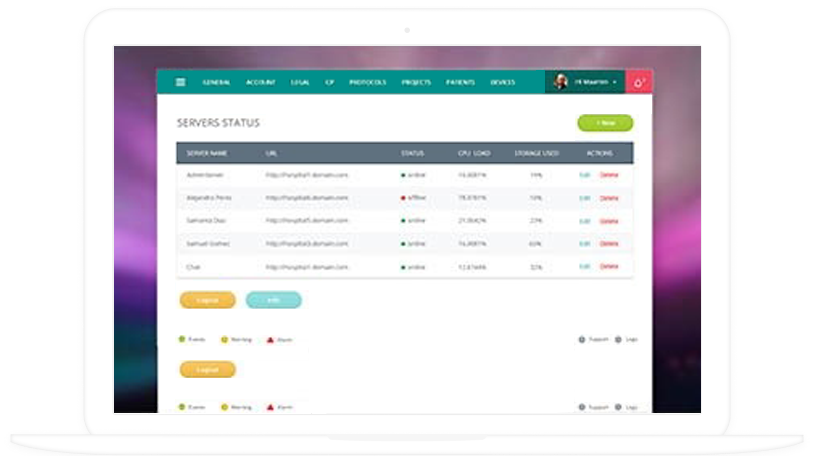Cutting-Edge RPM Software: Enhance Patient Outcomes with Technology
Cutting-Edge RPM Software: Enhance Patient Outcomes with Technology
Blog Article
The Future of Health Care: Remote Patient Keeping Track Of Streamlined
As healthcare proceeds to evolve, one area that holds enormous assurance is remote client surveillance. With a focus on improving client results and streamlining medical care delivery, remote monitoring is positioned to transform the market.
Advantages of Remote Client Monitoring
Remote client monitoring presents a wide range of advantages for both health care providers and patients alike. One substantial benefit is the capability to continuously monitor people' crucial indications and health data remotely. This real-time surveillance allows healthcare service providers to detect any kind of concerning patterns or adjustments promptly, leading to very early interventions and possibly avoiding medical emergency situations. Additionally, remote person tracking improves the general top quality of treatment by providing a more all natural and extensive sight of clients' wellness status past standard in-person gos to.
Additionally, remote patient tracking can cause better patient outcomes and contentment. Patients can enjoy the benefit of getting treatment in the comfort of their own homes while still understanding that their wellness is being very closely monitored. This can result in enhanced client interaction and adherence to therapy plans, eventually bring about far better wellness end results. Furthermore, remote monitoring can decrease the requirement for regular healthcare facility brows through, decreasing medical care prices for both people and service providers. In general, the advantages of remote client monitoring are clear, making it an important device in modern-day health care distribution.
Innovation Driving Remote Surveillance
In the realm of contemporary healthcare, technical improvements play a critical duty in driving the development and effectiveness of remote person tracking. The integration of cutting-edge innovations such as wearable devices, mobile applications, and cloud-based systems has actually reinvented the way health care service providers from another location monitor and take care of client wellness - software for remote patient monitoring. These modern technologies allow continual real-time monitoring of essential signs, medicine adherence, and various other important wellness data, enabling for prompt interventions and individualized treatment plans
One secret technology driving remote surveillance is the Web of Points (IoT), which makes it possible for smooth connectivity in between clinical tools and health care systems. IoT devices such as smartwatches and cordless sensors accumulate and transfer patient data to centralized platforms, facilitating remote monitoring from anywhere in the world. Man-made knowledge (AI) and machine knowing algorithms additionally improve remote surveillance by examining vast amounts of patient data to spot patterns, anticipate health and wellness patterns, and alert doctor to potential concerns.
Influence on Healthcare Distribution
With the assimilation of innovative modern technologies driving remote patient monitoring, the influence on healthcare distribution is coming to be progressively profound and transformative. Remote patient monitoring permits medical care carriers to supply even more positive and customized like patients, bring about enhanced health and wellness outcomes and lowered health center admissions. By from another location tracking important signs, symptoms, and medication adherence, medical care experts can intervene early, protecting against issues and improving the overall he said high quality of care.
In addition, remote tracking improves access to medical care services, specifically for individuals in country or underserved locations. Individuals can receive constant monitoring and support from their homes, eliminating the demand for regular in-person visits. This not just conserves time and minimizes costs for both individuals and healthcare centers but also decreases the danger of direct exposure to contagious conditions, an important factor to consider in the present healthcare landscape.
Additionally, remote individual monitoring allows doctor to far better focus on and allot resources care based upon real-time information. By recognizing high-risk clients and stepping in promptly, healthcare shipment comes to be extra efficient and efficient, eventually bring about a more sustainable and patient-centered health care system.
Improving Person End Results

In addition, RPM permits aggressive monitoring of persistent problems, minimizing the probability of severe worsenings and hospital readmissions. Clients take advantage of raised benefit and comfort, as they can get treatment in their own homes while remaining linked to their medical care providers. This continual surveillance not just improves client complete satisfaction but also promotes a sense of empowerment and involvement in their very own health and wellness management.
Future Trends in Remote Monitoring
Welcoming advanced modern technologies in remote client surveillance is forming the future landscape of healthcare distribution. One substantial trend is the enhanced usage of wearable tools and sensors to gather real-time information, enabling healthcare carriers to web link monitor individuals continually without the need for frequent in-person sees.

Moreover, telehealth systems are becoming a lot more innovative, allowing for online appointments, remote medical diagnosis, and remote person keeping track of done in one incorporated system (best remote browse around this web-site patient monitoring software). This all natural strategy to remote monitoring is improving health care distribution, boosting person satisfaction, and eventually, enhancing general high quality of treatment
Conclusion
Finally, remote individual tracking uses countless benefits in health care distribution, driven by innovations in modern technology. It has the possible to boost patient outcomes and revolutionize the way healthcare is provided. Future fads in remote surveillance will certainly proceed to form the landscape of health care, supplying chances for more efficient and personalized person treatment.
Remote individual tracking provides a multitude of advantages for both healthcare carriers and clients alike. In addition, remote client tracking enhances the total high quality of care by providing an extra all natural and extensive view of people' health and wellness status past conventional in-person gos to.
Moreover, remote individual monitoring can lead to better client outcomes and contentment. Remote client surveillance allows medical care companies to offer even more proactive and tailored care to people, leading to improved wellness outcomes and minimized medical facility admissions. Remote individual monitoring (RPM) plays a substantial function in improving individual end results by offering continual, real-time data that allows medical care service providers to interfere promptly and change therapy strategies as needed.
Report this page